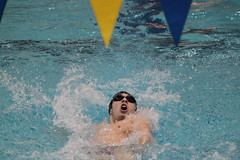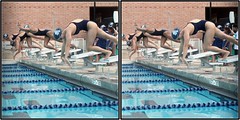Sunday, December 25, 2011
Saturday, December 17, 2011
Tuesday, November 29, 2011
Saturday, November 19, 2011
SWIMMING IN VEGAS! (11/29/09-270)
Thursday, November 17, 2011
Monday, November 14, 2011
Saturday, November 12, 2011
Saturday, November 5, 2011
Monday, October 31, 2011
Friday, October 28, 2011
Sunday, October 23, 2011
Wednesday, October 19, 2011
World Book of Swimming: From Science to Performance (Sports and Athletics Preparation, Performance, and Psychology)
!: The Top 10 Places to Buy World Book of Swimming: From Science to Performance (Sports and Athletics Preparation, Performance, and Psychology) purchase
Before 1970, scientific research in swimming was poor and anecdotal, and the improvements of performance were linked firstly to the swimmer's experience and, secondly, as a result of permanent research for speed. Before and after the Second World War, scientific studies were conducted by pioneers and marked the beginning of research in stroke mechanics and swimming physiology exercise. This book reviews research on the body of knowledge available for the improvement of sports coaching and training practice in swimming, which seems to be relevant, numerous, and diversified enough to help swimming coaches bridge the gap between theory and practice.
Sunday, October 16, 2011
Tuesday, April 19, 2011
Swimming - The Right Way to Exercise
Swimming is one of the easiest exercises there is. You need minimal equipment and it is a lot of fun. Even if you don't know how to swim, you can take heart from the fact that most people learn easily, irrespective of their age or level of fitness. Swimming can help you lose weight, develop a stunning body and achieve total all-round fitness. So, swimming as an exercise might seem to be a winner all round.

While there is no refuting the various benefits of swimming, to get maximum benefit from swimming as an exercise, it is important that you know what you should and should not do while swimming.
Swimming
If you want maximum gain from swimming as an exercise, you've got to understand one cardinal rule: thrashing furiously in the water will only exhaust you; it will not get you moving faster in the water. To get maximum mileage from your strokes, you need to know how to swim efficiently. You need to learn how to travel faster with each stroke and how to distribute the work equally among all the muscles of your body. This way, you would not injure yourself or kill your desire to swim.
!1: Now is the time Kanu Surf Men's Maui Trunks, Navy, Medium Order Today!
Mens 9 inches inseam microfiber printed volley
Different strokes for different people, they say, and there's a lot of truth in that. The variations in swimming styles are not there for fun and competitiveness alone. Some strokes are better than others when it comes to dealing with specific injuries. For instance, the breast stroke is best for people suffering from an injured shoulder. The back stroke is good for the muscles at the back of the hand and for people who cannot abide the water splashing into their eyes and face. The side stroke can improve the strength of the hand while providing a lot of flexibility for underwater movement.
Swimming is an exercise. So, take the same steps you would normally take to warm up and condition your muscles before you start swimming. 300-400 meters of gentle strokes can warm up all your muscle groups. Kicking in the water while holding on to something increases the flow of blood to your legs. This will prevent muscle strain.
When swimming for fitness, remember to increase effort only as you progress. You aim is not to break down from exhaustion. Regulate the number of strokes and swim gently, pausing every once in a while until you are ready to take on tougher challenges.
Just as in other sport activities, it is important to cool down before you stop. A slow and easy 250-400 meter swim is enough to wind up your swimming exercise nicely.
Swimming as an exercise has many advantages.
- Strengthens muscles
- Improves flexibility
- Strengthens bones
- Builds endurance
- Improves cardiovascular health
- Helps weigh loss
- Improves metabolism
But these benefits of swimming become available to the exerciser only when they adopt the right practices.
Swimming - The Right Way to ExerciseLuxury and splendor of tits balloon contest! Video Clips. Duration : 24.78 Mins.Suddenly a huge lift to the sky fluctuations coast new frontier. And earlier this huge lift Queen Miya Higashikazuno laughing loudly in the center of girls in bikini costume enthusiast extra-tight. What a delightful prospect! E 'sports day in a bathing suit to commemorate the completion of an orbital elevator. The girls for the first prize of one million yen by Higashikazuno Zaibatu (industrial conglomerates) sponsored wrestling. It's random insightsSo what?
Tags: gong, anime, manga, koi, seven, girl, sexy, panties
!: Stanton Digipak Pro Guide !: Brand New Echo Pb 251 Blower
Saturday, April 9, 2011
Mastering Swimming (The Masters Athlete Series)
!1: Now is the time Mastering Swimming (The Masters Athlete Series) Order Today!
Trim seconds off your time, train more efficiently, or simply maximize your fitness workouts with Mastering Swimming.
Renowned coaches Jim Montgomery and Mo Chambers have teamed up to create the ultimate swimming guide for masters athletes. Swimmers aged 18 to 120 will benefit from a targeted approach that covers these essentials:
-Stroke instruction and refinement for freestyle, breaststroke, backstroke, and butterfly
-Workout plans for fitness and competition
-Training for open-water swimming and triathlon
-Second-saving starts and turns
In addition, Mastering Swimming covers equipment, dryland training, motivational strategies, and guidance for selecting a masters coach or program. With such complete coverage, it's the one resource you'll turn to time and again for a lifetime of serious swimming.
!: Michael Kors Stormy Rain Boots Compare !: Gatorade Isotonic Drink
Monday, March 28, 2011
Swimming - Benefits of a Family Sport
One of the oldest water sports is swimming. What makes it more inviting is that the sport has the least number of injuries compared to other sports. During vacation, beaches, water parks and lakes are filled with swimming enthusiasts.

Recently, man has realized the importance to own a fit and healthy body. Science shows that swimming is beneficial to developing ones blood circulation, while providing a way to stretch the muscles.
Swimming
With the ease one moves in water, swimming offers minimal force requirement, while one building one's power and heart beat capacity and endurance.
!1: Now is the time Speedo Pull Buoy Royal/Grey Order Today!
This is a great training tool to build strength and endurance during your lap work outs. Our Pull Buoy is one of Speedo's best selling items. Train on and train strong with Speedo, the water experts and most popular swim brand in the world!
With the benefits above, people promoting health would include swimming in the fitness regime. It is used to maintain one's body mass and shape.
Not only is swimming serious work, but also fun for relaxation and recovering one's health.
Families who could afford a swimming pool choose to build one in the comforts of their own house.
For those who are already into the game, they turn professionals. Some become lifeguards assigned to beaches or swimming pools. They help save lives of those people who find face problems in swimming while in the beach or pool. Others become swim team coach who lead swimmers whether amateur or professionals. As the coach, one lectures swimmers on the different strokes and provides insights on techniques in building stamina.
When going swimming, one should also consider one's attire. Proper swimming outfit reduces friction and allows free movement.
Friction between the body and water causes resistance to the body which gives it a good work-out when you work through the water. A lot of water activities take advantage of this like water aerobics and water ballet. Water-based activities enhance a person's metabolism and exercise each part of the body.
For beginners, a great way of mastering the various swim strokes is to take swimming classes from a professional. It's recommended that you know how to swim by the time you are eight years old.
Swimming - Benefits of a Family SportMarc Broussard - Home Tube. Duration : 4.18 Mins.music video for implementation Marc Broussard Home. (C) 2005 The Island Def Jam Music Group
Tags: Marc, Broussard, Island, Rock
Friday, March 18, 2011
Swimming Lessons For Life
Swimming Lessons are a necessity in life. Teaching your child to swim is just as important as teaching your child to walk.

Drowning is the second leading cause of death in children under the age 14, auto accidents is number one, so you can see how important it is that your child learns to swim at a very early age.
Swimming
Children are very curious near water and are not able to understand the dangers. It is believed that most children drown quietly without splashing or calling for help when they find themselves in trouble in the water. Most children drown when a adult is nearby but was temporarily distracted.
!1: Now is the time Speedo Pull Buoy Royal/Grey Order Today!
This is a great training tool to build strength and endurance during your lap work outs. Our Pull Buoy is one of Speedo's best selling items. Train on and train strong with Speedo, the water experts and most popular swim brand in the world!
A study was done in the Journal of Pediatrics in relationship between the child's age and place of drowning. What they found was that babies most often drown in bathtubs when left unattended, even for a few minutes. Toddlers drown most often in swimming pools or backyard ponds. Most children who drown in pools were last seen inside the home and had been out of sight for less than five minutes. Older children more often drown in large bodies of water such as lakes, rivers and oceans.
As you can see by the statistics, swimming lessons is a key component to your child living a long healthy life. It is your duty as a parent to make sure your child learns how to swim. If you can't teach them, then you need to find somebody who can.
Make sure your instructor is a qualified swim instructor and not just a family friend who might think they know how to swim. There are many important things that a child needs to learn for there safety that most people don't learn on there own.
Your child is not to young to learn to swim (babies have been swimming for 9 months before birth) and naturally are very comfortable in the water. Also your child is not to old to learn to swim.
Don't put your child at risk any longer, go find a swim school or private instructor in your area immediately.
Swimming Lessons For LifeMr. Bean goes to the pond, swimming pool Tube. Duration : 4.22 Mins.Funny and hilarious Mr. Bean (Rowan Atkinson) goes to the pool, but what happened? : D Watch and laugh! Mr. Bean best video of all time (in my opinion).
Keywords: Mr.bean, mr., bean, funny, hilarious, crazy, excellent, goes, to, the, swimming, pool, humour, british, actor, swim, great, britain, lol
!: Promotional Toro S-200 Snowblower !: Coach Convertible Bag Save You Money! !: Interview Remington Electric Hedge Trimmer
 |
 |
 |
 |
 |
 |
 |
 |
Sponsor Links
- Power Tool Cheap
- Buy Digital Video Cameras Now!
- World llc Articles Mild Of Organization
- Coupon Rebar Shaker Head Select Insert 1: 6-7, Select Insert 2: 4-5...
- Poulan Chainsaw Troubleshooting Quickly
- Good Bargain Non Convertible Cribs
- Shopping Charlie Banana Diaper System Under Construction...
- Fisher Mobile Buy Online
- Cheapest Gorham Old French (sterling,1905,no Monograms) One Tine Butter Pick...
- Discount Summon Night: Twin Age...







 Great Deal : $21.00Date Created :Apr 19, 2011 16:06:26
Great Deal : $21.00Date Created :Apr 19, 2011 16:06:26


